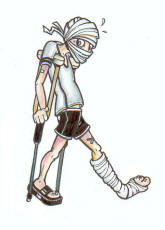Exercise when You’re Hurting
 The following article is a small excerpt from one of my books. I hope you’ll want to learn more and let me help you to get into the best shape of your life.
The following article is a small excerpt from one of my books. I hope you’ll want to learn more and let me help you to get into the best shape of your life.
Smart Exercise Swaps
“No pain, no gain” won’t work as an exercise mantra if you’re already injured. In fact, pushing yourself too hard when you’re hurting can land you at the doctor’s office (or worse). Still, aches and pains are no excuse to cut out exercise altogether—you just have to be smart about it.
To help you pick a safe but satisfying workout when you’re injured, I’ve chosen 8 more common injuries and how to pick a substitute.
Carpal tunnel syndrome
It’s often caused by…
Repetitive motions, such as typing or writing, gardening, needlework, and golfing; or swelling due to diseases such as rheumatoid arthritis. Women’s smaller wrists make them three times more likely than men to develop carpal tunnel.
You should avoid…
Push-ups, plank pose, and any other exercise that involves excessive bending the wrist forward or back; racquet sports can also cause flare-ups.
Instead, you should try…
Chest exercises where you can keep wrists straight and protected—using machines or dumbbells. Most exercises should be fine. If you play sports, make sure your equipment is the proper size and fit.
Back pain
It’s often caused by…
Muscular strains, arthritis, soft-tissue injuries, and disc disease; or sports such as golfing, tennis, running, and bowling.
You should avoid…
Running, particularly downhill running, overhead lifting, the leg press machine or anything that aggravates the pain should be avoided.
Instead, you should try…
Walking, stretching, protected abs exercises, swimming, recumbent bike, yoga and Pilates work well. Also, be sure to wear the appropriate shoes for your sport.
Shoulder pain
It’s often caused by…
Impingement occurs when the space between your rotator cuff muscles and the bone on top of your shoulder narrows, pinching the tendons. Arthritis and bursitis can also cause shoulder pain.
You should avoid…
Repetitive overhead exercises, such as overhead presses or lifts with free weights, as well as pastimes that require similar movements. Activities like gardening and painting, which inherently don’t cause any damage, could flare up the pain if done for hours.
Instead, you should try…
Front shoulder raises instead of overhead presses and lateral raises. Also temporarily eliminate sports and exercises that involve repetitive shoulder movements such as tennis and golf.
Shin splints
It’s often caused by…
A sudden increase in running mileage or intensity when you’re running or exercise walking.
You should avoid…
Running frequently, especially if you’re in pain. You don’t necessarily have to stop running altogether unless the symptoms are severe or getting worse. Just cut back.
Instead, you should try…
Cross training combined with other forms of cardiovascular exercise, such as swimming or biking, that don’t involve repetitive impact.
Plantar fasciitis
It’s often caused by…
Tight calf muscles, foot-arch problems, long distance running, and sudden weight gain.
You should avoid…
Nothing. But if you’re in pain, reduce any exercises with repetitive lower extremity impact, such as running.
Instead, you should try…
The elliptical trainer or bicycle may be preferable to running, as they do not subject the foot to the same stresses.
Neck pain
It’s often caused by…
Stress, osteoarthritis, carrying a heavy bag over one shoulder, cradling a phone between your shoulder and neck, degenerative discs, and poor posture while sitting at a desk.
You should avoid…
Some yoga positions, such as headstands, that put pressure on your neck, running or other high-impact moves that trigger neck pain should be avoided too.
Instead, you should try…
Walking, cycling, Pilates, and yoga positions that do not involve your head or neck stands.
Twisted ankle
It’s often caused by…
Rolling or twisting your ankle in an awkward way that stretches or tears the ankle ligaments.
You should avoid…
Any repetitive impact (like running or jogging) should be avoided in the days after the initial injury.
Instead, you should try…
Focusing on upper-body exercise or non-weight-bearing workouts such as a stationary biking or swimming. To regain range of motion, draw the letters of the alphabet with your toes.
Swollen knee
It’s often caused by…
A tear in the meniscus (which is a c-shaped cartilage shock absorber in the knee) or ACL tears. Patellofemoral pain—pain behind the kneecap—is the most likely cause of knee pain.
You should avoid…
Any exercise that recreates the pain, especially impact and stress such as running, lower extremity weights, and activities where you’re jumping or changing direction. Consider backing off of Stairmaster-type exercises.
Instead, you should try…
Swimming, water aerobics, some yoga and/or Pilates if modified to avoid certain painful exercises. Also, include daily hip, thigh, and knee strengthening exercises, such as leg raises.
Whether you want to look good or increase your athletic performance it’s important to train The book ‘Get Fit Stay Fit’ details some of the most effective exercises and routines to help you with your overall development.
I know you want to get in shape and look great. Whatever your fitness goal…to slim down…gain muscle…tone your arms or flatten your tummy…I’m here to help you accomplish your goals and to improve your fitness level. If you have enjoyed this article and the many other free features on my site, and would like some more comprehensive information such as fitness books and CD’s to aid you in achieving your health and fitness goals, please visit myONLINE STORE where you will find innovative natural health and beauty products to help you become the BEST YOU CAN BE !

